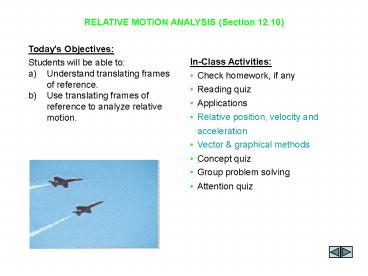Lecture Notes for Section 12.10 (Relative Motion) - PowerPoint PPT Presentation
1 / 18
Title:
Lecture Notes for Section 12.10 (Relative Motion)
Description:
Title: Lecture Notes for Section 12.10 (Relative Motion) Author: Alimi Last modified by: Joel Ness Created Date: 2/9/2001 8:00:18 PM Document presentation format – PowerPoint PPT presentation
Number of Views:205
Avg rating:3.0/5.0
Title: Lecture Notes for Section 12.10 (Relative Motion)
1
RELATIVE MOTION ANALYSIS (Section 12.10)
- Todays Objectives
- Students will be able to
- Understand translating frames of reference.
- Use translating frames of reference to analyze
relative motion.
In-Class Activities Check homework, if
any Reading quiz Applications Relative
position, velocity and acceleration Vector
graphical methods Concept quiz Group problem
solving Attention quiz
2
READING QUIZ
- 1. The velocity of B relative to A is defined as
- A) vB vA . B) vA vB .
- C) vB vA . D) vA vB .
- 2. Since vector addition forms a triangle,
there can be at most _________ unknowns (either
magnitudes and/or directions of the vectors). - A) one B) two
- C) three D) four
3
APPLICATIONS
When you try to hit a moving object, the
position, velocity, and acceleration of the
object must be known. Here, the boy on the
ground is at d 10 ft when the girl in the
window throws the ball to him.
If the boy on the ground is running at a constant
speed of 4 ft/s, how fast should the ball be
thrown?
4
APPLICATIONS (continued)
When fighter jets take off or land on an aircraft
carrier, the velocity of the carrier becomes an
issue.
If the aircraft carrier travels at a forward
velocity of 50 km/hr and plane A takes off at a
horizontal air speed of 200 km/hr (measured by
someone on the water), how do we find the
velocity of the plane relative to the
carrier? How would you find the same thing for
airplane B? How does the wind impact this sort of
situation?
5
RELATIVE POSITION
The absolute position of two particles A and B
with respect to the fixed x, y, z reference frame
are given by rA and rB. The position of B
relative to A is represented by rB/A rB
rA
Therefore, if rB (10 i 2 j ) m
and rA (4 i 5 j ) m, then rB/A (6 i
3 j ) m.
6
RELATIVE VELOCITY
To determine the relative velocity of B with
respect to A, the time derivative of the relative
position equation is taken. vB/A vB
vA or vB vA vB/A
In these equations, vB and vA are called absolute
velocities and vB/A is the relative velocity of B
with respect to A. Note that vB/A - vA/B .
7
RELATIVE ACCELERATION
The time derivative of the relative velocity
equation yields a similar vector relationship
between the absolute and relative accelerations
of particles A and B.
aB/A aB aA or aB aA aB/A
8
Solving Problems
Since the relative motion equations are vector
equations, problems involving them may be solved
in one of two ways. For instance, the velocity
vectors in vB vA vB/A could be written as
Cartesian vectors and the resulting scalar
equations solved for up to two unknowns.
Alternatively, vector problems can be solved
graphically by use of trigonometry. This
approach usually makes use of the law of sines or
the law of cosines.
Could a CAD system be used to solve these types
of problems?
9
LAWS OF SINES AND COSINES
Since vector addition or subtraction forms a
triangle, sine and cosine laws can be applied to
solve for relative or absolute velocities and
accelerations. As review, their formulations are
provided below.
10
EXAMPLE
Given vA 600 km/hr vB 700
km/hr Find vB/A
Plan a) Vector Method Write vectors vA and vB
in Cartesian form, then determine vB
vA b) Graphical Method Draw vectors vA and vB
from a common point. Apply the laws of sines and
cosines to determine vB/A.
11
EXAMPLE (continued)
Solution
12
EXAMPLE (continued)
13
CONCEPT QUIZ
1. Two particles, A and B, are moving in the
directions shown. What should be the angle q so
that vB/A is minimum? A) 0 B) 180 C)
90 D) 270
2. Determine the velocity of plane A with respect
to plane B. A) (400 i 520 j ) km/hr B) (1220 i
- 300 j ) km/hr C) (-181 i - 300 j ) km/hr D)
(-1220 i 300 j ) km/hr
14
GROUP PROBLEM SOLVING
Given vA 10 m/s vB 18.5 m/s
at)A 5 m/s2 aB 2 m/s2 Find vA/B
aA/B
Plan Write the velocity and acceleration vectors
for A and B and determine vA/B and aA/B by using
vector equations.
Solution The velocity of A is vA 10
cos(45)i 10 sin(45)j (7.07i 7.07j) m/s
15
GROUP PROBLEM SOLVING (continued)
The velocity of B is vB 18.5i (m/s)
16
GROUP PROBLEM SOLVING (continued)
The acceleration of B is aB 2i (m/s2)
17
ATTENTION QUIZ
1. Determine the relative velocity of particle B
with respect to particle A. A) (48i 30j)
km/h B) (- 48i 30j ) km/h C) (48i - 30j )
km/h D) (- 48i - 30j ) km/h
2. If theta equals 90 and A and B start moving
from the same point, what is the magnitude of
rB/A at t 5 s? A) 20 ft B) 15 ft C) 18
ft D) 25 ft
18
(No Transcript)































